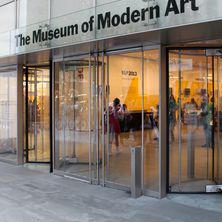

The MOMA is the second most visited museum in New York after the Metropolitan Museum of Art and is ranked 13th in the world. Its collection, however, is more diverse than the Met's, which makes it a more well-rounded museum by today's standards. That 150,000-work collection includes paintings, sculptures, drawings, photography, prints, illustrated books, architectural models, design projects, artist's books, film and electronic media, all dedicated to modern and contemporary art.
The museum was conceived and developed by Abby Aldrich Rockefeller, wife of John Rockefeller, Junior, along with her friends Lillie Bliss and Mary Quinn Sullivan in 1929. They rented a floor in a building on the corner of Fifth Avenue and 57th Street and with museum director Alfred H. Barr, Jr., exhibited works from the European modernism school, the first museum in America to do so. In that same year the museum organized an exhibition that changed the course of American art, introducing the public and experts to Van Gogh, Gauguin and Cezanne.
Abby was frequently at odds with her husband over modern art. He preferred the objectivity of the classics, while she was interested in subjective art, which had already gained momentum at the turn of the century. He thus was reluctant to spend family money on works that did not meet his tastes. As a result, the MOMA found difficulty in keeping up with the rent and changed several locations in the 1930s. Finally, Abby was able to convince her husband of the importance of the "new" movements and in 1939 he donated a portion of the Rockefeller land to construct the building that constitutes the fundamental part of the current museum. Their son David, who today is the oldest living member of the Rockefeller family, is still the museum's honorary chairman.
In 1940 the museum held a Picasso exhibition, which proved to be an enormous success with New Yorkers, establishing the MOMA as the predominant modern art authority in the world. In 1958 the museum suffered a fire that completely destroyed Claude Monet's Water Lilies on the second floor. The Water Lilies painting that we see today - Monet had painted many of them - is a replacement. The building was expanded several times: in the 60s with a small addition, in the 80s with a bigger one and in the 2000s with an extension that doubled its original exhibition space.
MOMA continuously organizes modern and contemporary art exhibitions dealing with a wide range of mediums and periods. It involves the public in all its activities and initiatives, especially in lectures, conferences and courses on modern art. The museum's admission price is $25, and unlike the Metropolitan Museum of Art, the price is not recommended - it is mandatory.